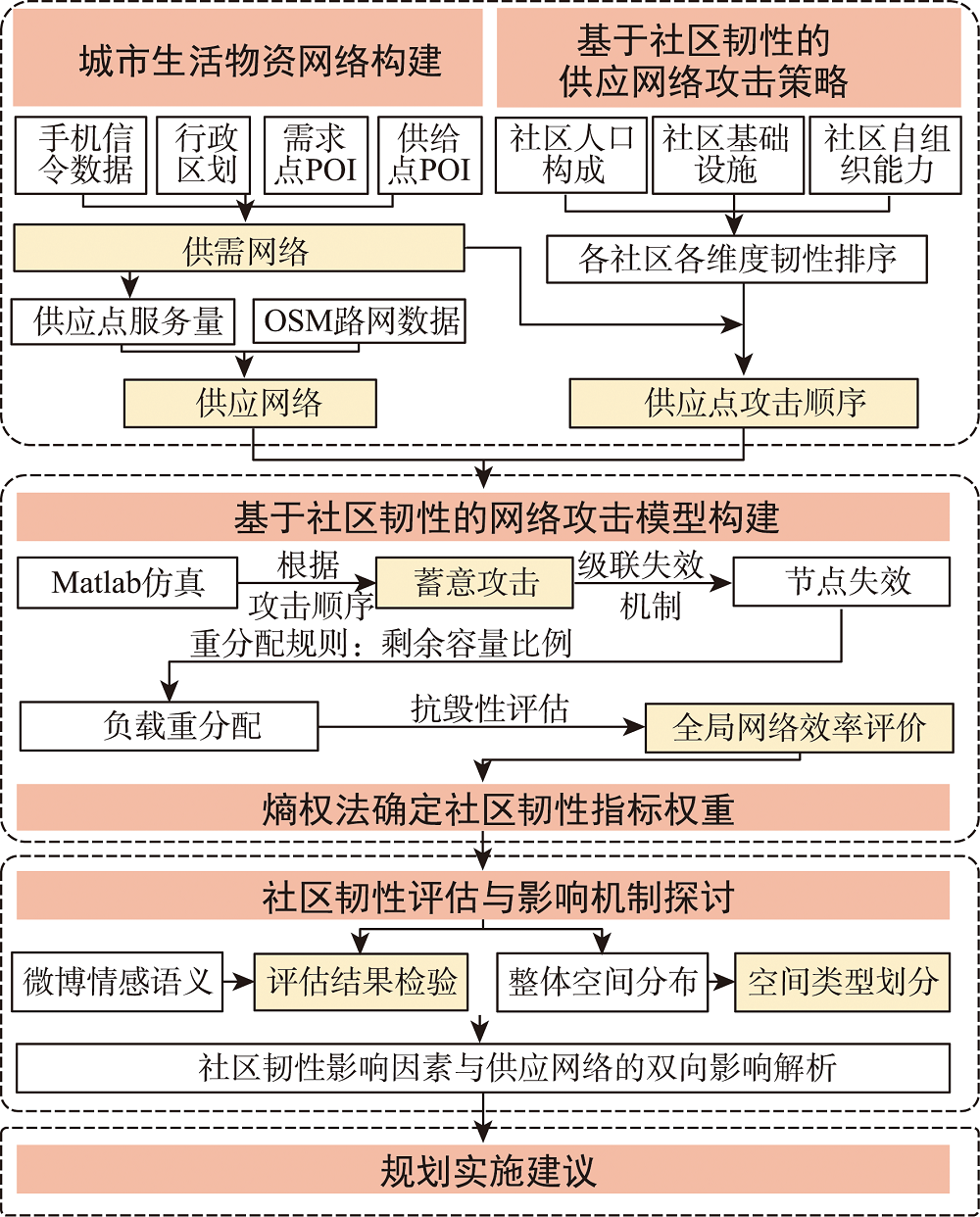

Journal of Geo-information Science >
An Evaluation Method of Community Supply Support and Resilience Based on Complex Network
Received date: 2023-04-19
Revised date: 2023-10-04
Online published: 2023-12-05
Supported by
National Natural Science Foundation of China(52078217)
State Key Laboratory Foundation of Subtropical Building and Urban Science(2022KA01)
The assurance of a consistent supply of daily necessities in megacities is pivotal in fortifying community supply resilience. It is axiomatic that a community system is not an insular entity; rather, it intricately intertwines with various elements of urban systems. As a foundational unit of urban governance, the urban community is instrumental in facilitating a congruent nexus between supply and demand, thereby augmenting urban resilience. This study proposes an exploratory evaluation method for the urban community supply support and resilience based on complex network theory, attempting to achieve a breakthrough in the underlying theoretical framework of resilience assessment from "single system assessment" to "multi-system correlation assessment". Taking the six districts in the central city of Guangzhou as an example, we build a supply-demand network based on citizens' spatio-temporal behaviors using multi-source data such as mobile phone signaling data and other data. The attacking strategies of network are based on five community resilience indicators. Besides, the cascade failure mechanism is introduced to evaluate the network resilience, and the entropy-weighted method is employed to obtain resilience evaluation results. The influence mechanism of community resilience on the supply system is further analyzed by studying the factors affecting community node failure at different stages of supply network. The findings are as follows: (1) The proposed evaluation model of the community supply support and resilience can effectively simulate urban community supply-demand networks and evaluate the resilience of communities. Low-resilience communities are mainly categorized into three spatial types: old blocks, urban villages, and suburban blocks; (2) Through the analysis of network resilience under five different attack strategies, it is found that the dominant influencing factors are different, with the population density being the primary factor; (3) There exists a complex bidirectional relationship between community resilience and supply security, including the obvious vulnerability of low-resilience communities. And the community self-organization ability, the supply facility layout, and the linkage scheduling between supply points all affect the overall community resilience.

HUANG Hao , WANG Junchao , WANG Chengfang , XIE Yuanyi , ZHANG Wenchu . An Evaluation Method of Community Supply Support and Resilience Based on Complex Network[J]. Journal of Geo-information Science, 2023 , 25(12) : 2303 -2314 . DOI: 10.12082/dqxxkx.2023.230208
表1 社区供应保障与韧性评估指标体系Tab. 1 Influencing factor framework of community resilience evaluation |
| 韧性评估维度 | 指标要素 | 对韧性的影响 | 数据来源及计算方法 |
|---|---|---|---|
| 社区人口构成 | 人口密度 | 正向影响 | 手机信令;网格单元总人口/单元面积(%) |
| 老年人比例 | 正向影响 | 手机信令再校准;大于60岁人口/总人数(%),并根据广州统计年鉴进行校准(校准系数为1.214) | |
| 人均消费能力 | 负向影响 | 手机信令数据;综合话费与手机型号进行分级 | |
| 社区基础设施 | 商超密度 | 负向影响 | POI;计算方法:供应点POI数量(网格单元商场、超市等)/单元面积(%) |
| 社区自组织能力 | 非通勤人流比例 | 正向影响 | 手机信令;非通勤人数/总人数(%) |
表2 数据来源Tab. 2 Data source |
| 数据类型 | 数据说明 | 数据来源 | 年份 |
|---|---|---|---|
| 手机信令数据 | 包括非通勤OD、社区人口数、老年人比例、人均消费能力等信息,共 63 577条 | 中国联通智慧足迹 | 2021 |
| 需求点POI | 包括住宅区、宿舍等,共31 263个 | 百度地图开放平台API | 2022 |
| 生活物资供应点POI | 肉菜市场、前置仓、社区商超、购物中心等,共20 945个 | 百度地图开放平台API | 2022 |
| 交通道路路网 | 都市高速路 、高速公路 、省道 、县道 、乡镇道路 、行人道路 、其他道路 | OpenStreetMap | 2022 |
| 行政区划数据 | 后处理为500 m×500 m网格 | 国家地理信息公共服务平台 | 2022 |
| 社交媒体数据 | 微博签到与文本数据,共16.3万条 | 新浪微博 | 2021 |
注:① 手机信令数据于2021年9月采集,在此期间广州市几乎无新增境内确诊病例和境内无症状感染者,为常态化时期的人流OD信息,用于建立正常情况的供需网络;② 微博签到数据为2021年6月采集,该时期广州芳村与海珠中部等多地爆发疫情,从16万条数据中识别市民情感,将其作为实际案例检验低韧性社区识别结果。 |
| [1] |
段进, 杨保军, 周岚, 等. 规划提高城市免疫力——应对新型冠状病毒肺炎突发事件笔谈会[J]. 城市规划, 2020, 44(2):115-136.
[
|
| [2] |
|
| [3] |
|
| [4] |
李江川, 张健钦, 杨木, 等. COVID-19智能体模型及城市疫情封控措施评价研究[J]. 计算机工程与应用, 2022, 58(10):283-291.
[
|
| [5] |
|
| [6] |
|
| [7] |
|
| [8] |
|
| [9] |
范蕴玉. 国外社区韧性研究的知识图谱与热点前沿——基于Web of Science(2001―2020年)的可视化分析[J]. 温州大学学报(社会科学版), 2022, 35(1):81-95.
[
|
| [10] |
|
| [11] |
|
| [12] |
周霞, 毕添宇, 丁锐, 等. 雄安新区韧性社区建设策略——基于复杂适应系统理论的研究[J]. 城市发展研究, 2019, 26(3):108-115.
[
|
| [13] |
沈睿熙, 谭俊杰, 袁媛. 常态化防控要求下城市基层医疗设施规划研究 ——以广州为例[J]. 南方建筑, 2020(4):1-5.
[
|
| [14] |
武廷海, 宫鹏, 李嫣. 未来城市体系:概念、机理与创造[J]. 科学通报, 2022, 67(1):18-26.
[
|
| [15] |
魏玺, 甄峰, 孔宇. 社区智慧治理技术框架构建研究[J]. 规划师, 2023, 39(3):20-26.
[
|
| [16] |
张文佳, 季纯涵, 谢森锴. 复杂网络视角下时空行为轨迹模式挖掘研究[J]. 地理科学, 2021, 41(9):1505-1514.
[
|
| [17] |
|
| [18] |
何锦屏, 李双双. 多灾种时空耦合网络构建:从多维网到单顶点网[J]. 地理研究, 2021, 40(8):2314-2330.
[
|
| [19] |
|
| [20] |
牟能冶, 程驰尧. 面向突发事件的粮食铁水联运网络抗毁性研究[J]. 安全与环境学报, 2023, 23(3):713-723.
[
|
| [21] |
冯瑛杰, 谢庆红. 基于遗传算法的应急物流设施选址与调度[J]. 科技和产业, 2021, 21(9):102-106.
[
|
| [22] |
|
| [23] |
|
| [24] |
|
| [25] |
|
| [26] |
徐漫辰. 适灾韧性理念下的社区灾害脆弱性实证研究[J]. 规划师, 2019, 35(5):94-98.
[
|
| [27] |
|
| [28] |
郝羽成, 李成兵, 魏磊. 考虑节点过载的复杂网络级联失效模型[J]. 系统工程与电子技术, 2018, 40(10):2282-2287.
[
|
| [29] |
|
| [30] |
|
| [31] |
王兰, 胡沾沾, 赫磊. 基于疫情分析的上海社区韧性影响因素研究[J]. 城市发展研究, 2023, 30(4):60-66.
[
|
| [32] |
孙鸿鹄, 甄峰. 面向日常活动与环境供需矛盾的城市韧性综合评估及空间特征研究——以南京为例[J]. 地理研究, 2022, 41(10):2697-2711.
[
|
| [33] |
钟鸣, 肖璐, 张倩, 等. 山洪视角下社区韧性影响因素及其定量分析[J]. 地理科学进展, 2022, 41(3):423-436.
[
|
/
| 〈 |
|
〉 |